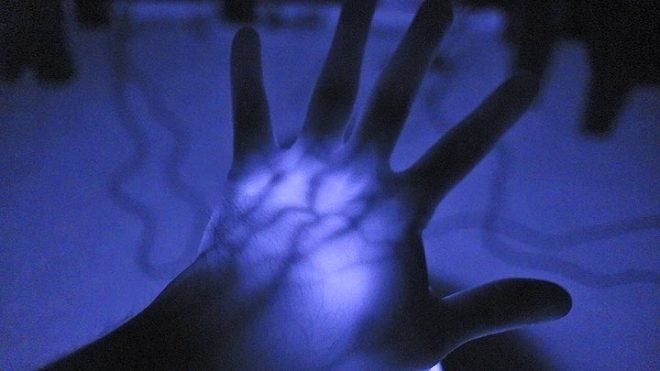Back in 2015 a biochemistry researcher, Gabriel Licina, volunteered to take Chlorin e6 eye drops to biohack his eyeballs for natural night vision. Fellow TFB writer Richard L. wrote an article about your actual Natural Night Vision. Well, recently scientists in China and the University of Massachusetts have developed an eyeball injection that allows mice to detect infrared light without compromising regular vision.
The video above explains how the scientists are using nanoparticles injected into the eyeball that convert IR light into visible light. Sort of like how night vision goggles work. Mammal eyes, yes that includes us as well, can only see in a narrow field which we call visible light spectrum.

That range is around 380nm to 740nm. NVGs can see 800-1000 nm as well as visible light. IR light can be detected by human eyes but it is dim and looks red. Ever notice the lights in a night vision security camera have a red glow? That is IR light. If you look at the NIR spectrum it is close to the red spectrum of visible light.
In the recently published Cell article, these scientists developed ocular injectable photoreceptor-binding upconversion nanoparticles. These nanoparticles bind themselves to the cones and rods of your eyes. According to the research paper, human eyes can detect 550nm spectrum the best. So they designed the nanoparticles to react to NIR but emit light at 535nm.
To convert NIR light to this wavelength, we generated core-shell-structured upconversion nanoparticles which exhibited an excitation spectrum peak at 980 nm and emission peak at 535 nm upon980-nm light irradiation
What does that mean? They inject your eyeballs and the stuff inside attaches to your rods and cones. When NIR photons enter your eyeballs the nanoparticles convert the light into visible light that your rods and cones can detect. This is technically how traditional night vision goggles work. They convert NIR light into visible light that your eye can see.
Sounds like a great idea right? See in the dark without expensive technology!!! There has to be a catch. I did not see it mentioned in the research paper but they did say the normal visible light detection was not affected. Ok, I will bite. I have to ask “what would that look like to see VIS and NIR spectrums?”
The closest approximation would be IR photography. Digital camera sensors can see NIR light. So they typically have a filter that blocks IR light from exposing the sensor. If you remove this filter your camera can photograph IR light.
The world looks kind of like this image below with the IR filter removed on a camera.

Here is a photo comparison of what a digital camera records with and without the IR blocking filter.

Before the IR filter has been removed

After the IR Filter has been removed
The two photos above are from a LifePixel article. They have been photoshopped a bit for better contrast and colors. But the point I am trying to make is that if your eyes could see NIR wavelength along with the visible spectrum, you would not see the world like normal. Colors would be screwed up. Certain objects absorb NIR while others reflect it. Leaves look odd under IR photography. In the photos above, they look white. If you have played with night vision goggles and looked at clothes, sometimes a black jacket looks white under IR light.
The other problem is that your eyes can’t really see in the dark. They are certainly the best things we have. Better than cameras (unless you do long exposures) and better than night vision goggles. Often extreme low light I can see better with my natural eyes than with night vision goggles. But once there is a little bit more ambient light or I use an IR illuminator (IR flashlight) then the night vision goggles are better.
With this nanoparticle eyeball injection, your eyes would still not amplify light like night vision goggles. It would just allow you to see a new color. You could sneak around the dark with an IR light and no one else could see you. If you had these injections performed you might have to wear special glasses that blocked IR light so you could see the normal color spectrum again. While the Cell research paper suggests that the mice could still see regular light, the mice can’t speak to us and describe what they are seeing. Could you still see normal colors without blocking IR light? I doubt it.
Edit: After talking to Richard L. about the potential to see in the dark with upconverting nano particles injected into your eyeballs, you would have problems sleeping at night. If you recall in my article about civilians owning night vision, IR light can shine through your hand and illuminate your veins. Now take this a step further. Your eyelids are much thinner than a hand and while I have no way of testing it, I imagine that if you closed your eyes to IR light you would still see it. So you would have to sleep with an eye mask or a room with zero ambient light in order to not have IR light leak through your eyelids.

It is exciting to see how technology is advancing and I am morbidly curious to see these night vision eyeball injections be tested on a human so he or she can describe what it is like to see in the dark.
For more information on Human NIR perception, you can read up on this article written by Gabriel Licina. Or read his research paper about the eyedrops. If you want to read the research paper on Mammalian Near-Infrared Image Vision through Injectable and Self-Powered Retinal Nanoantennae click here.
 Your Privacy Choices
Your Privacy Choices
